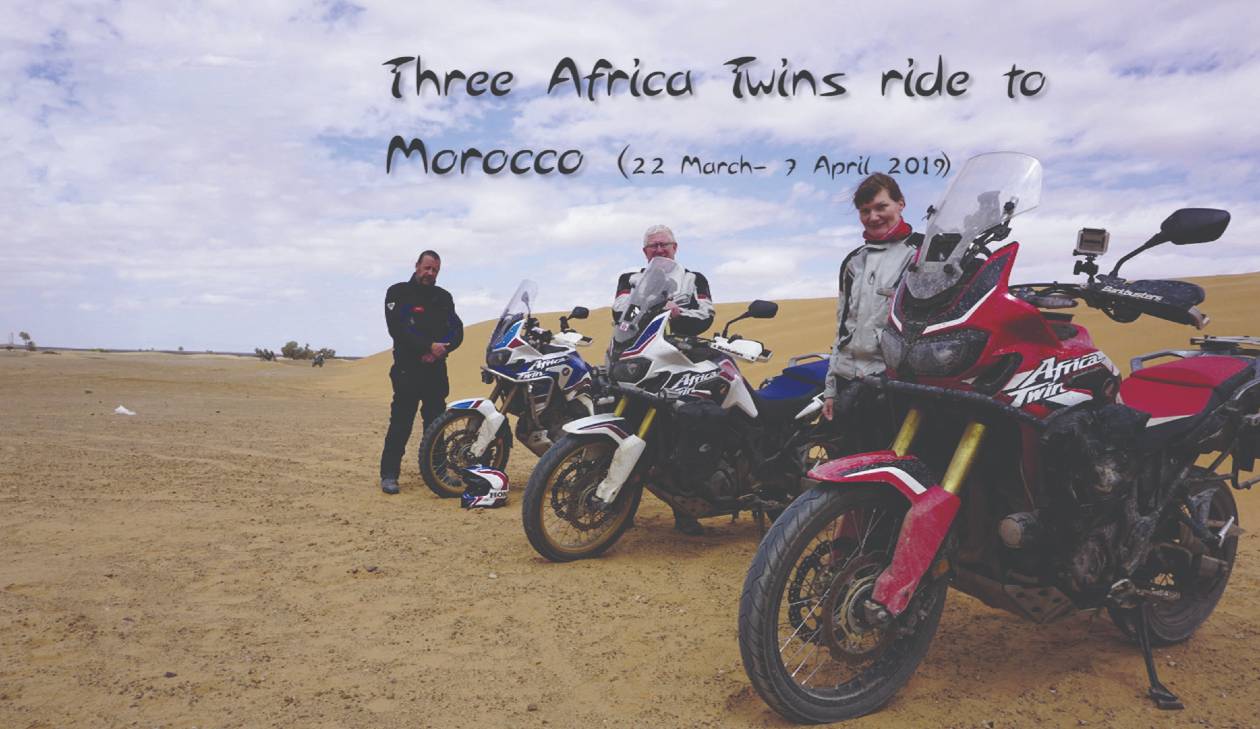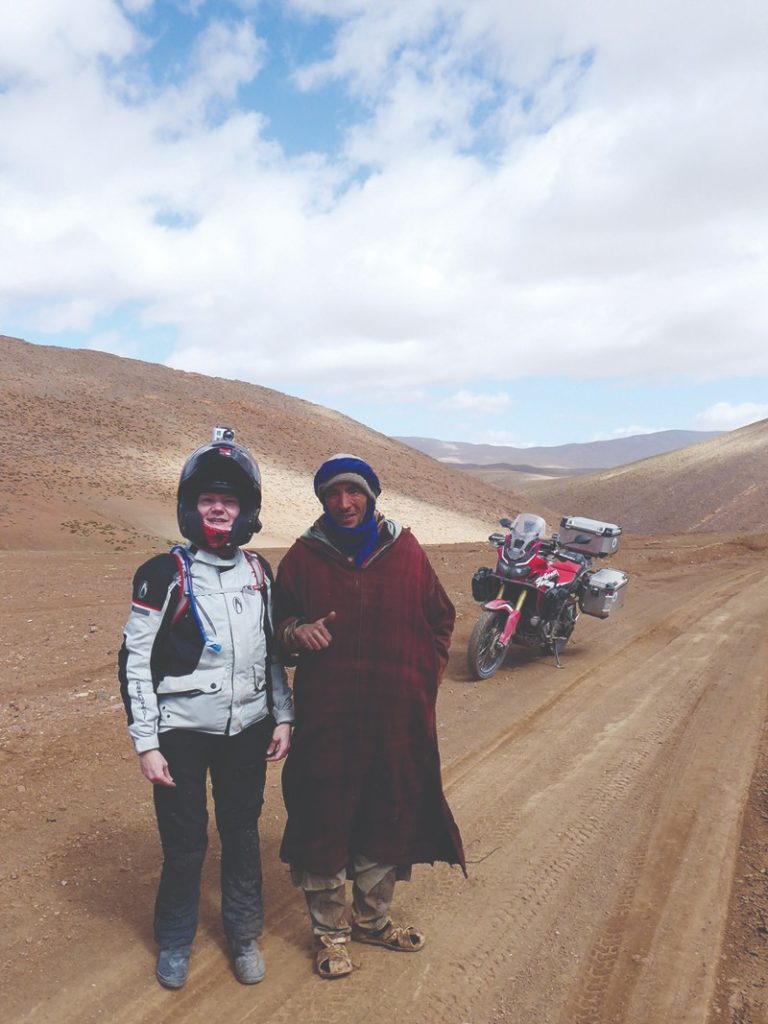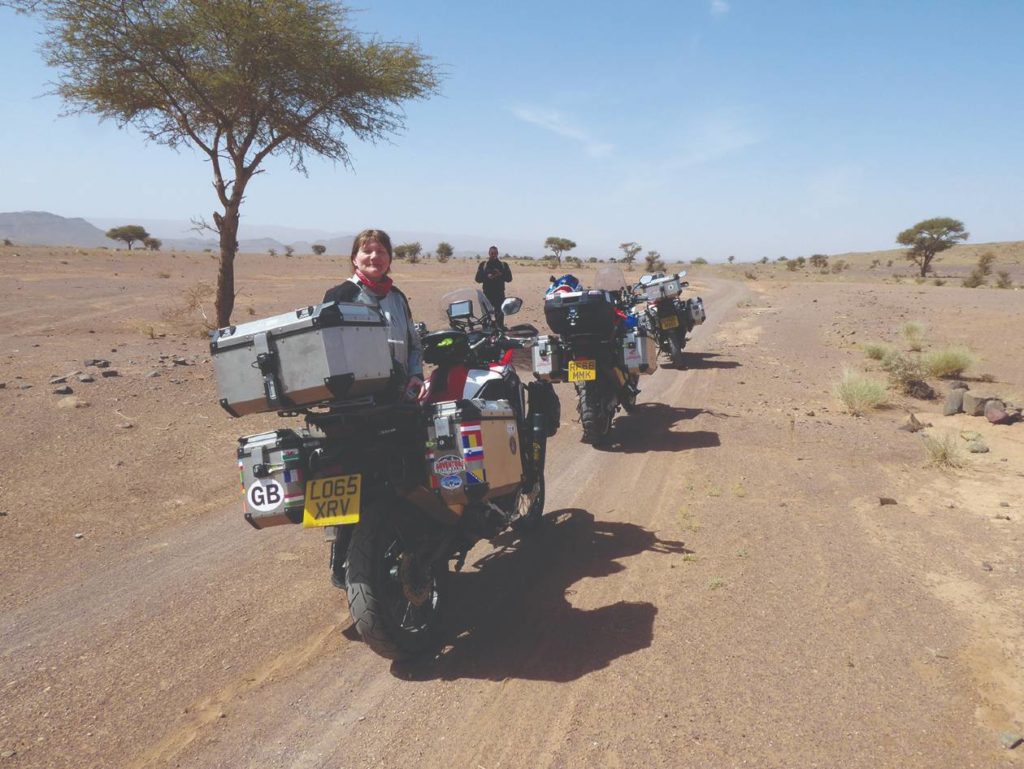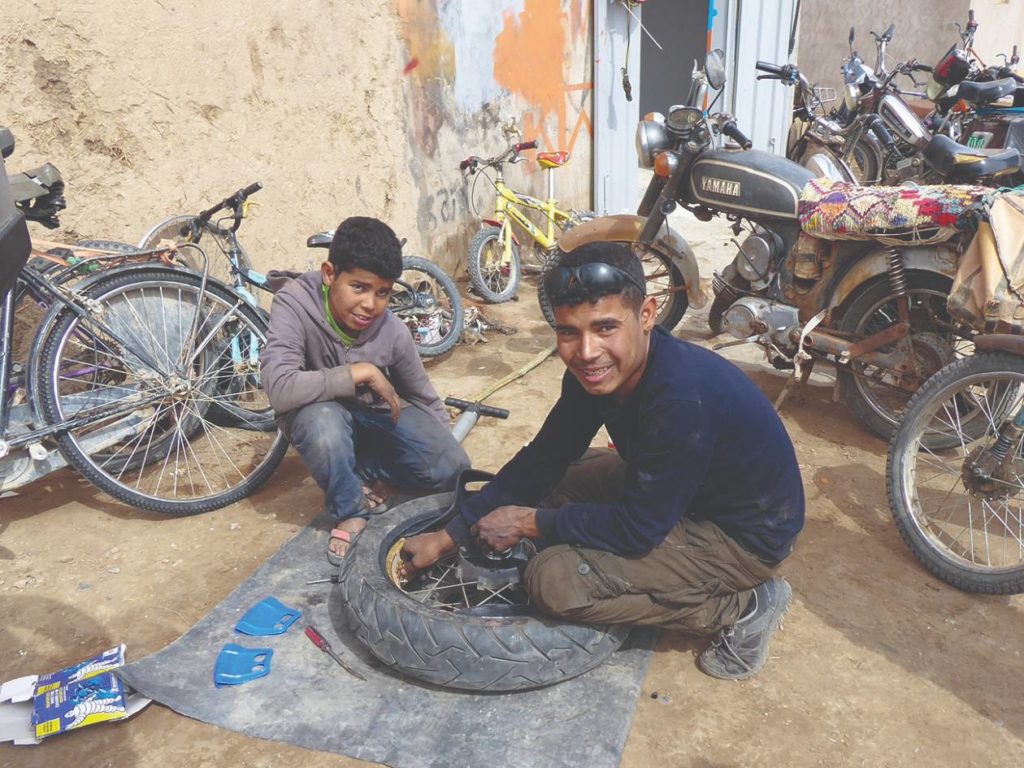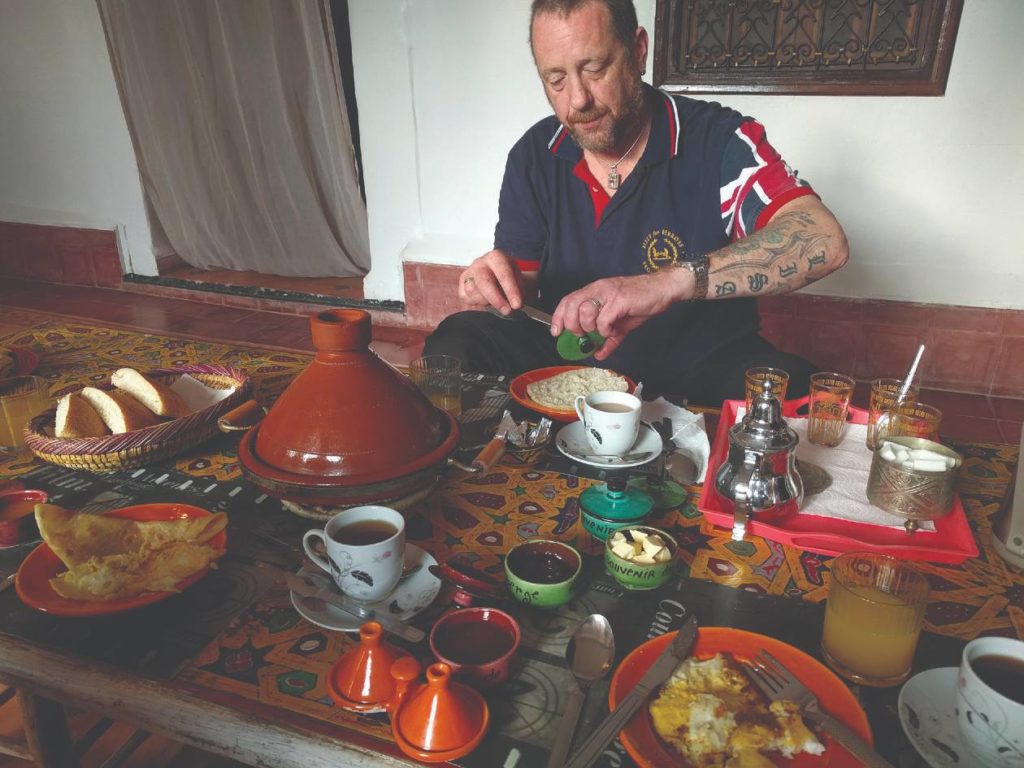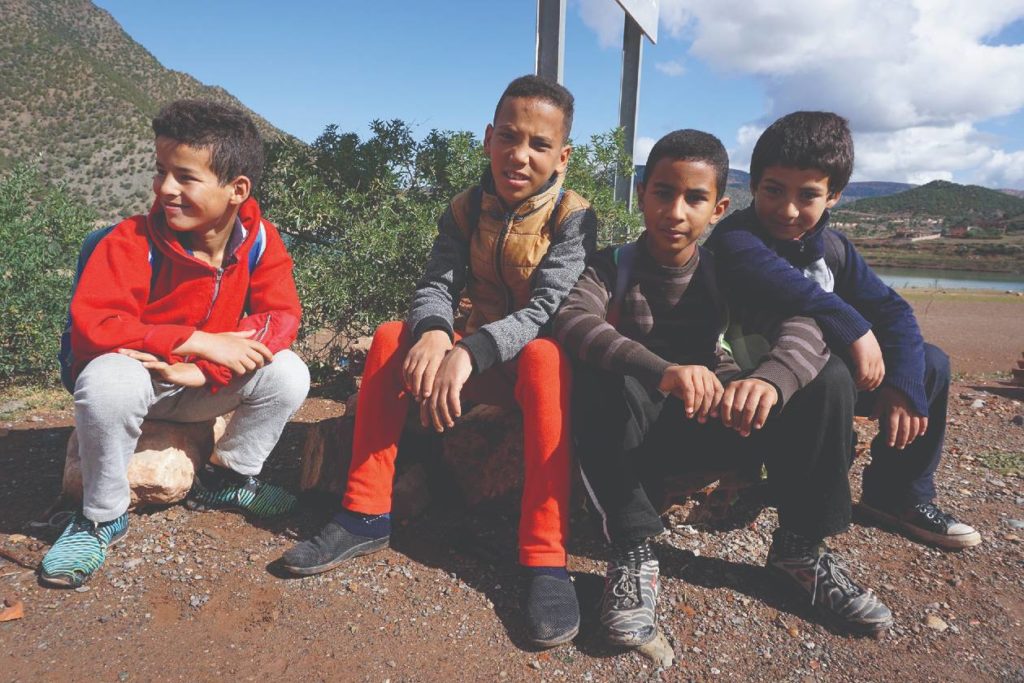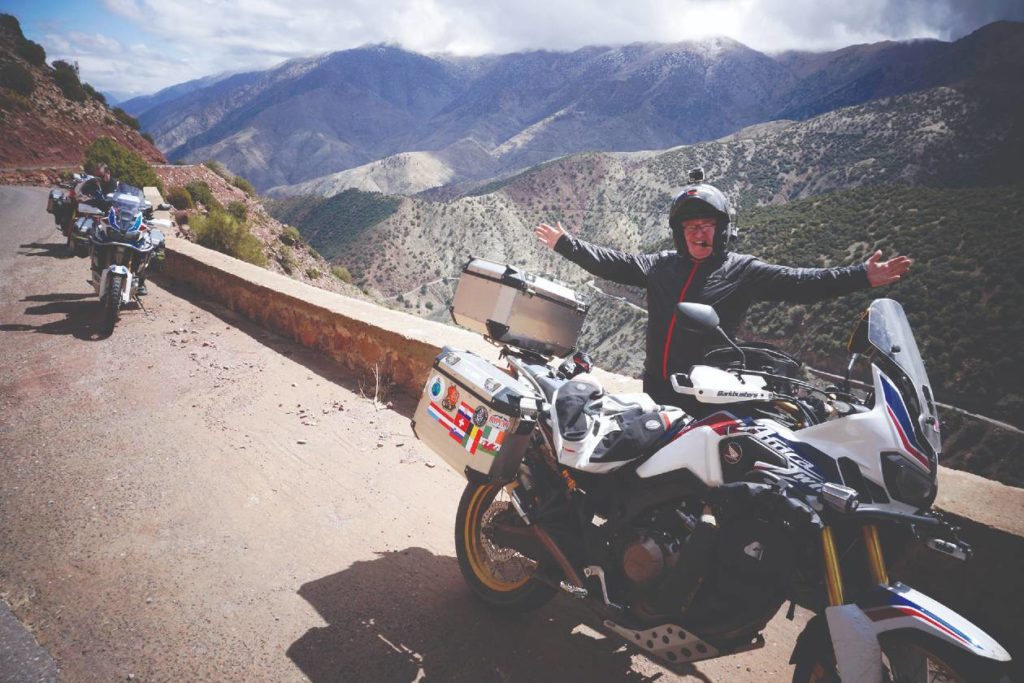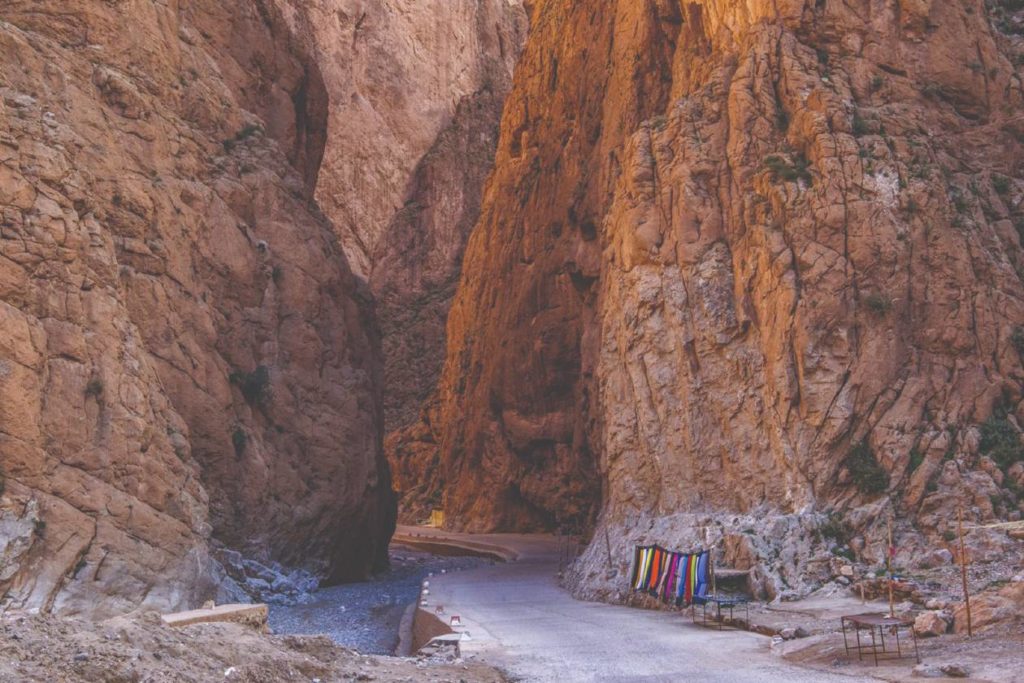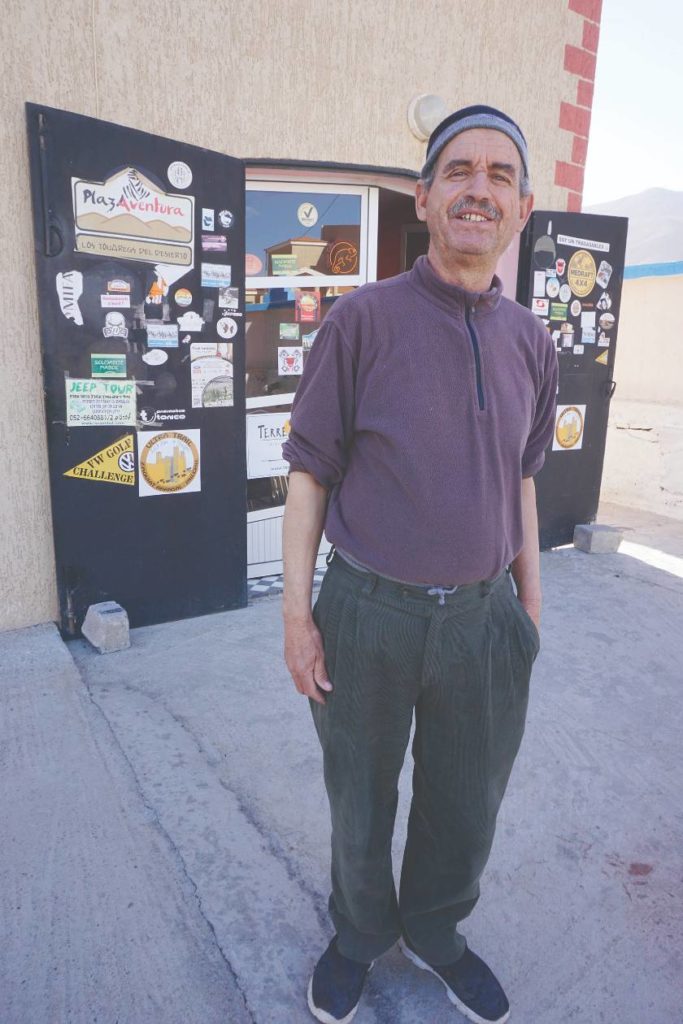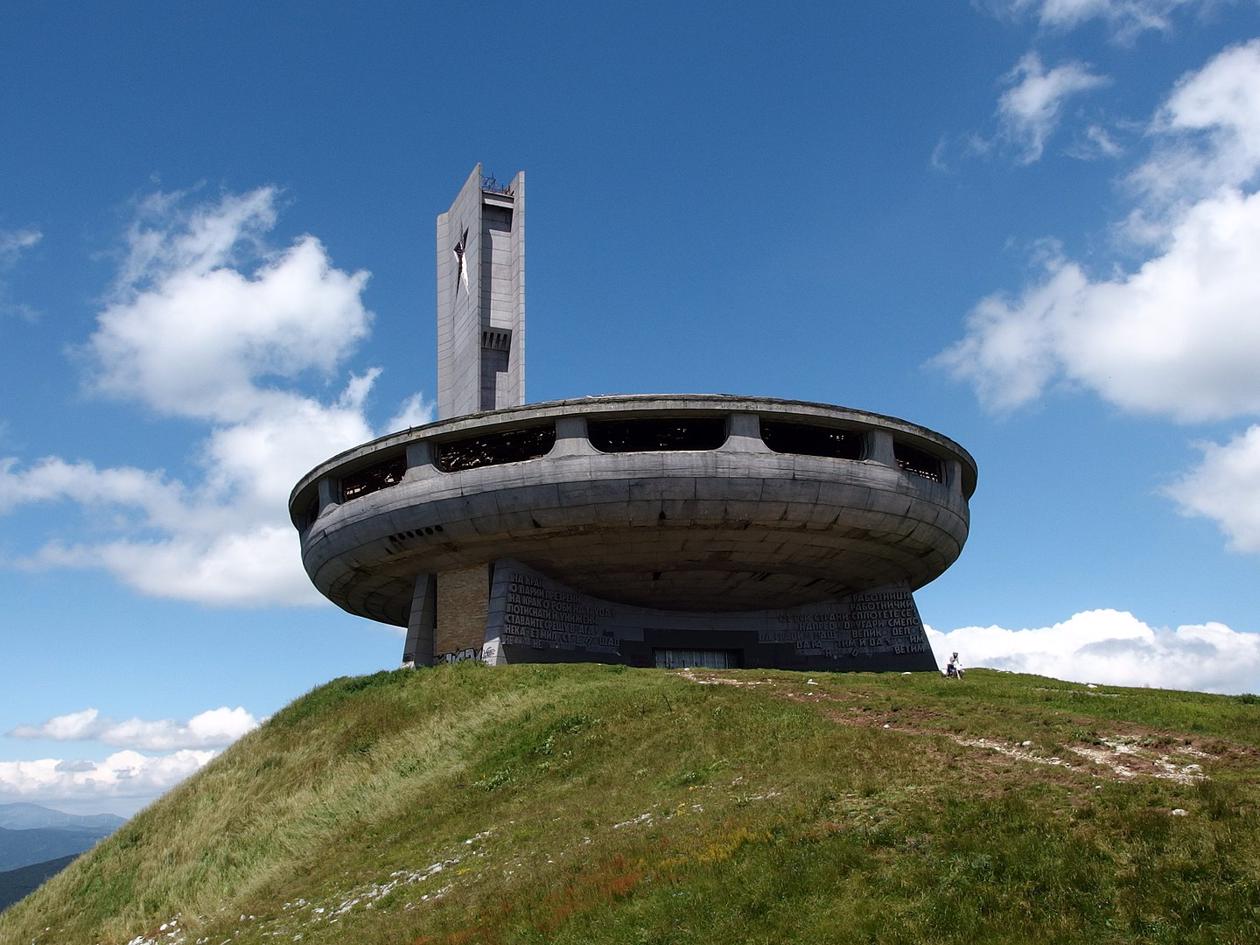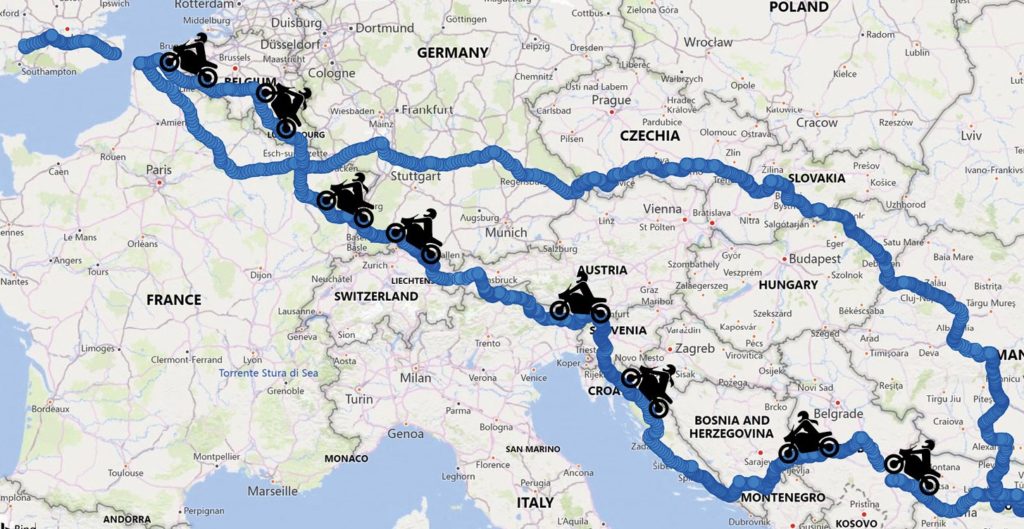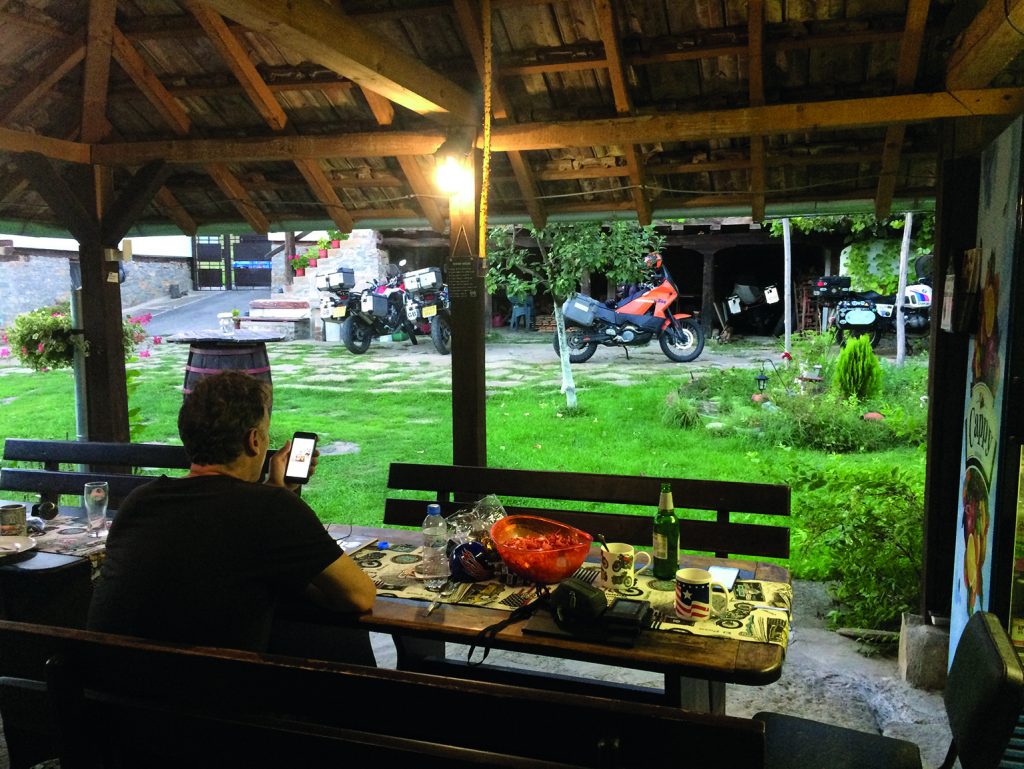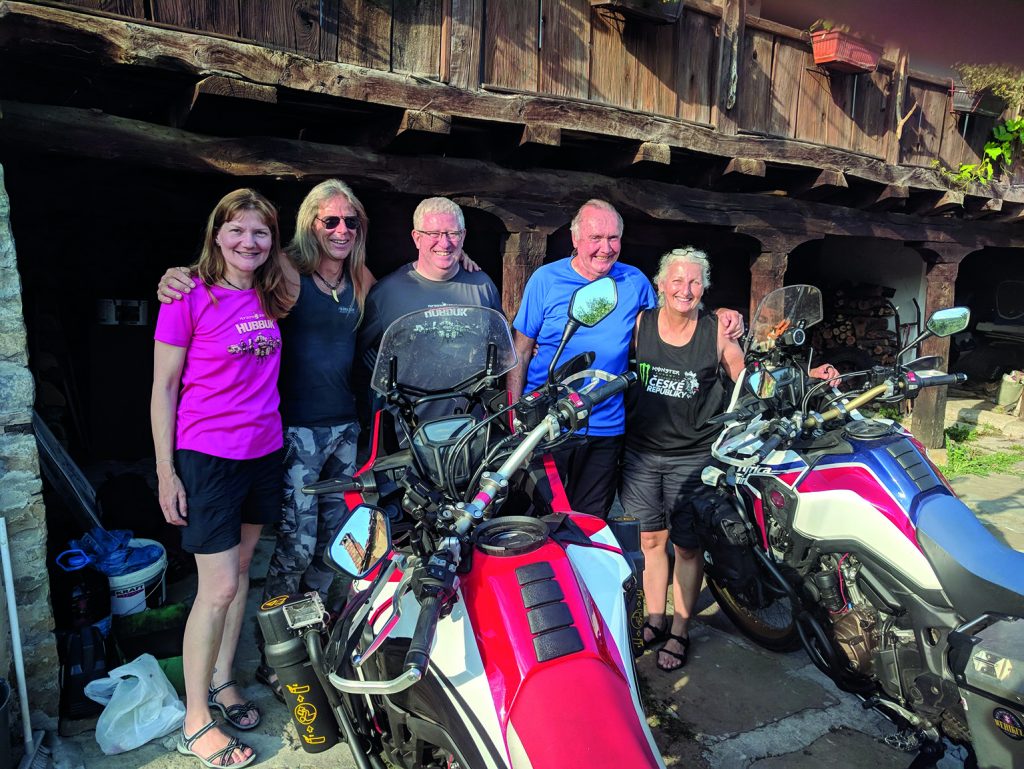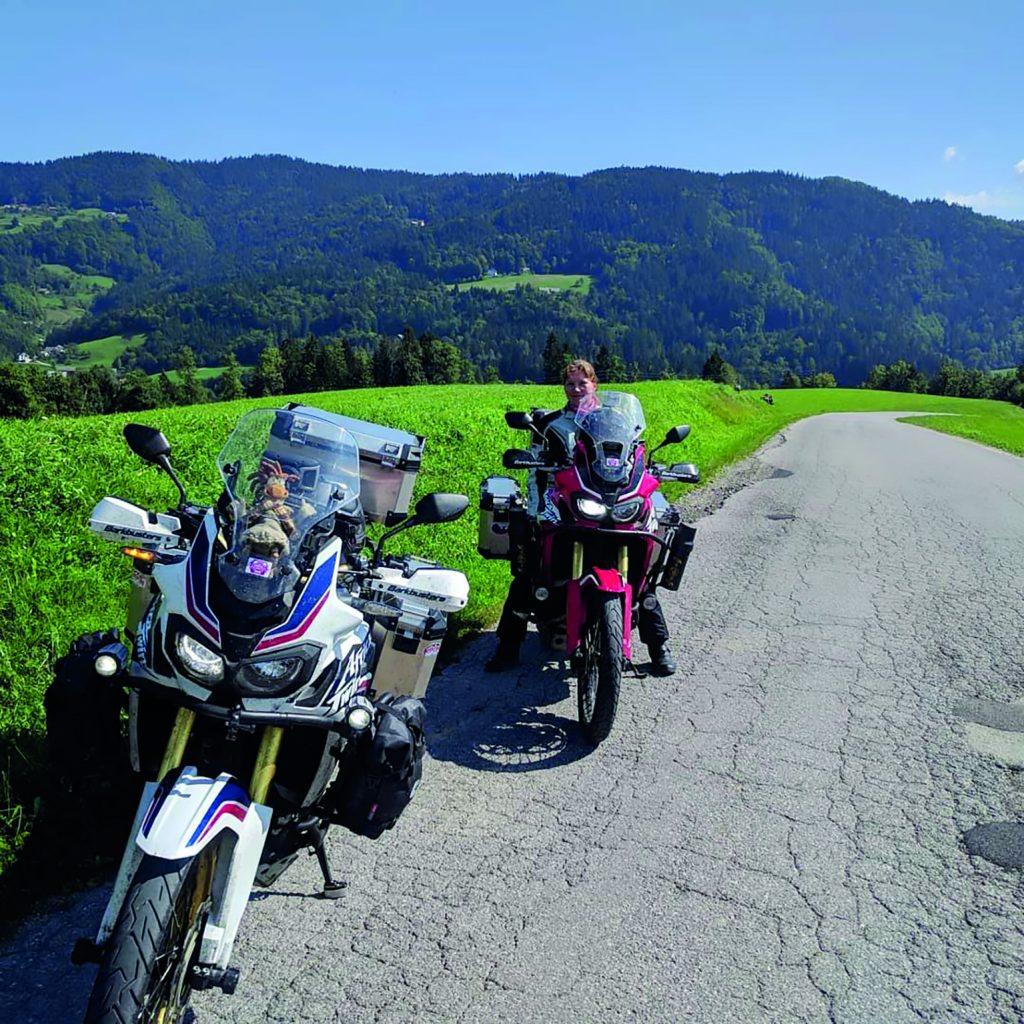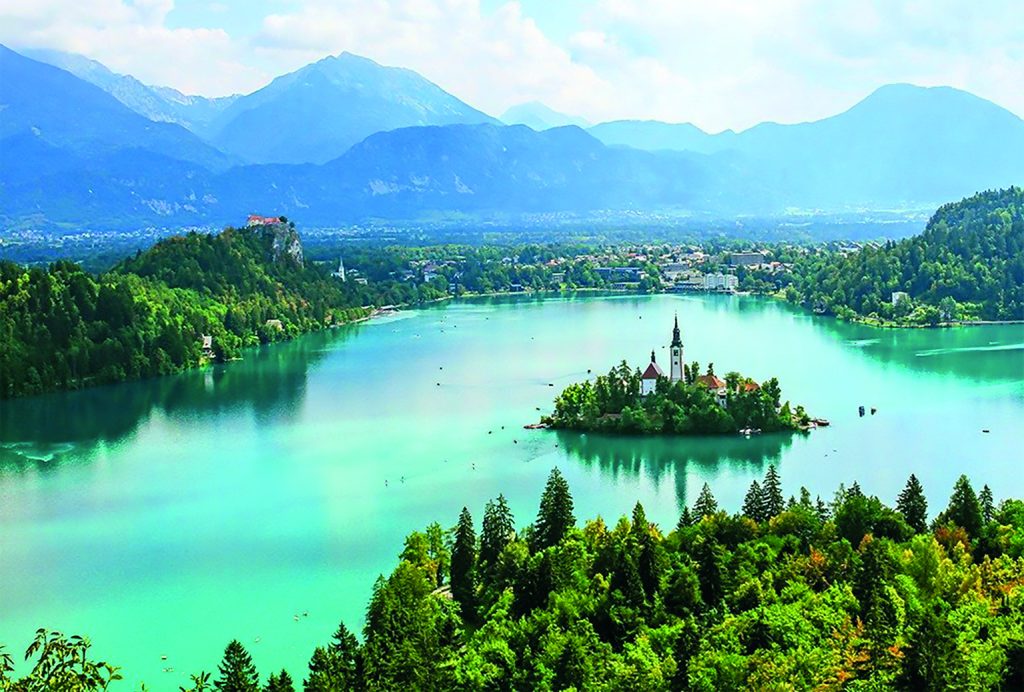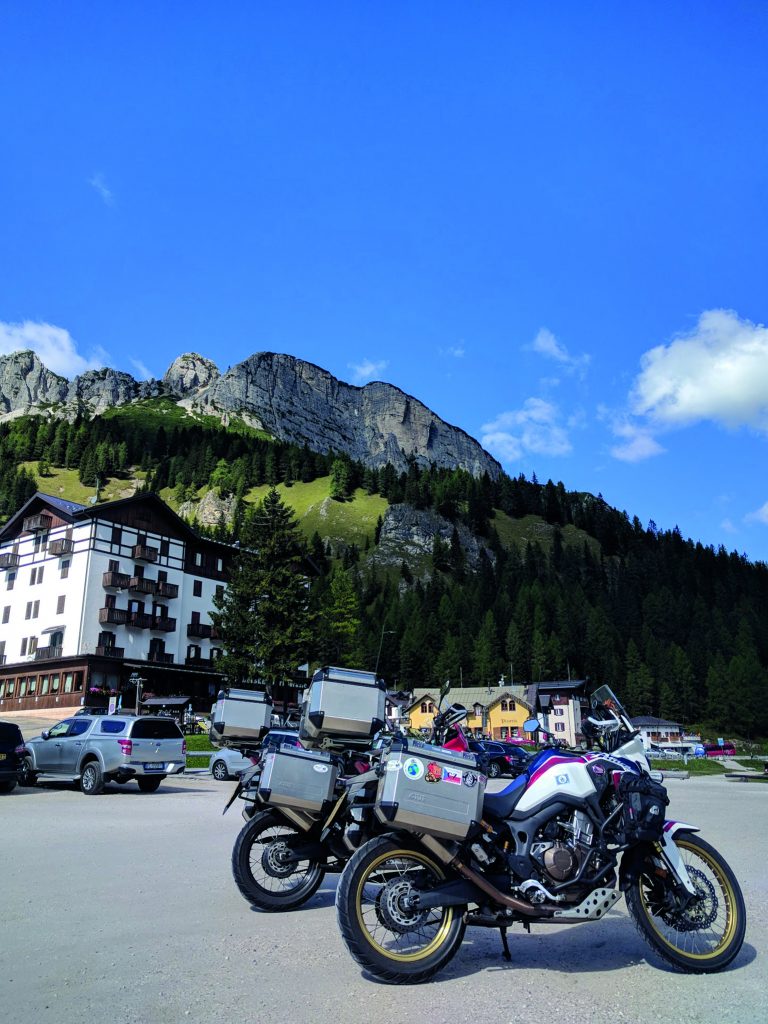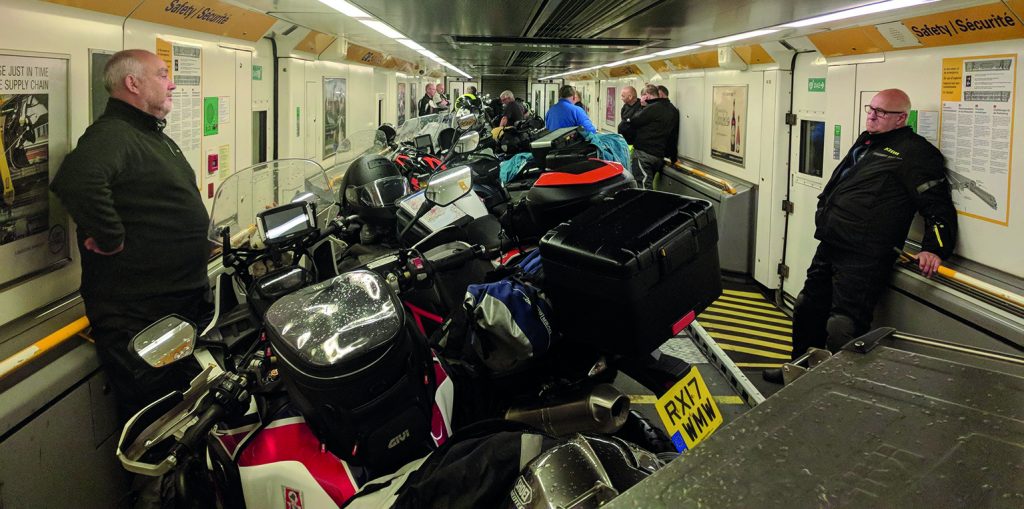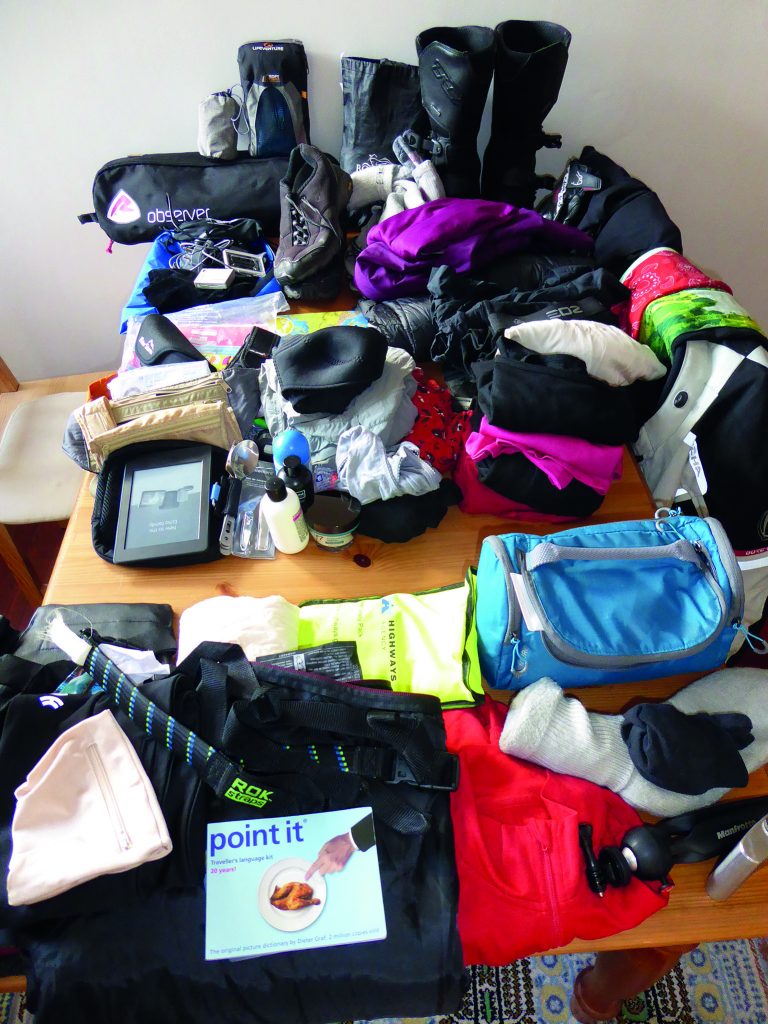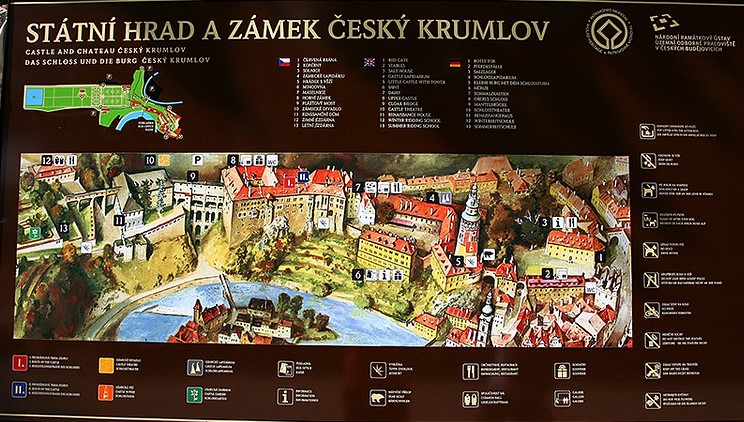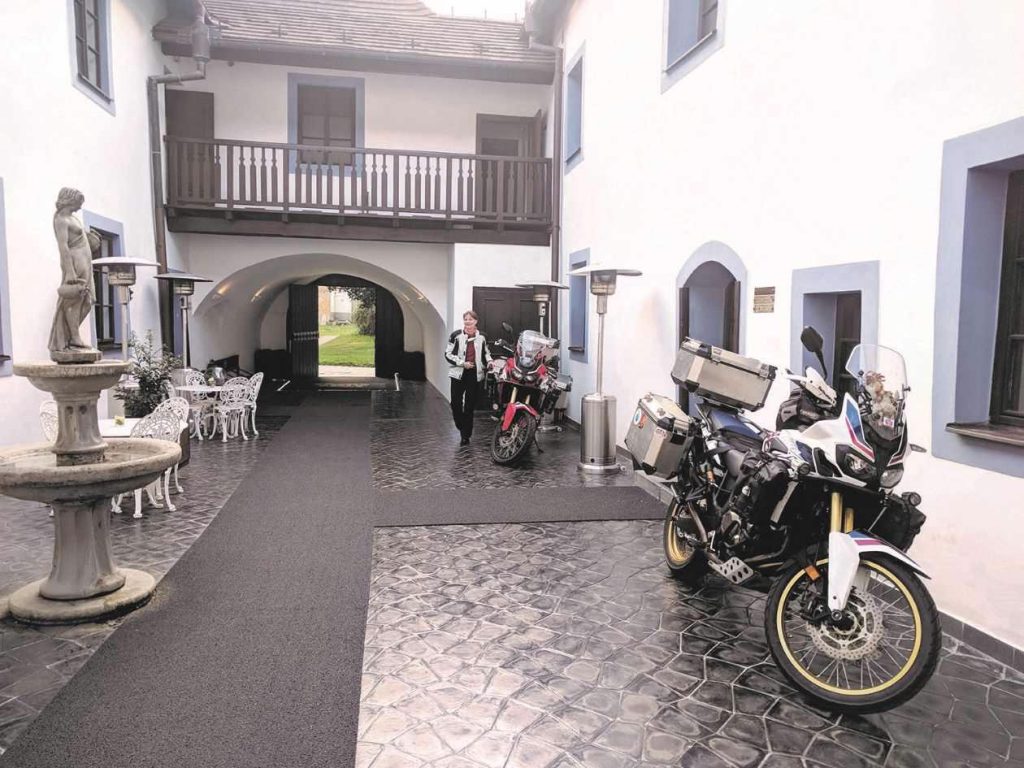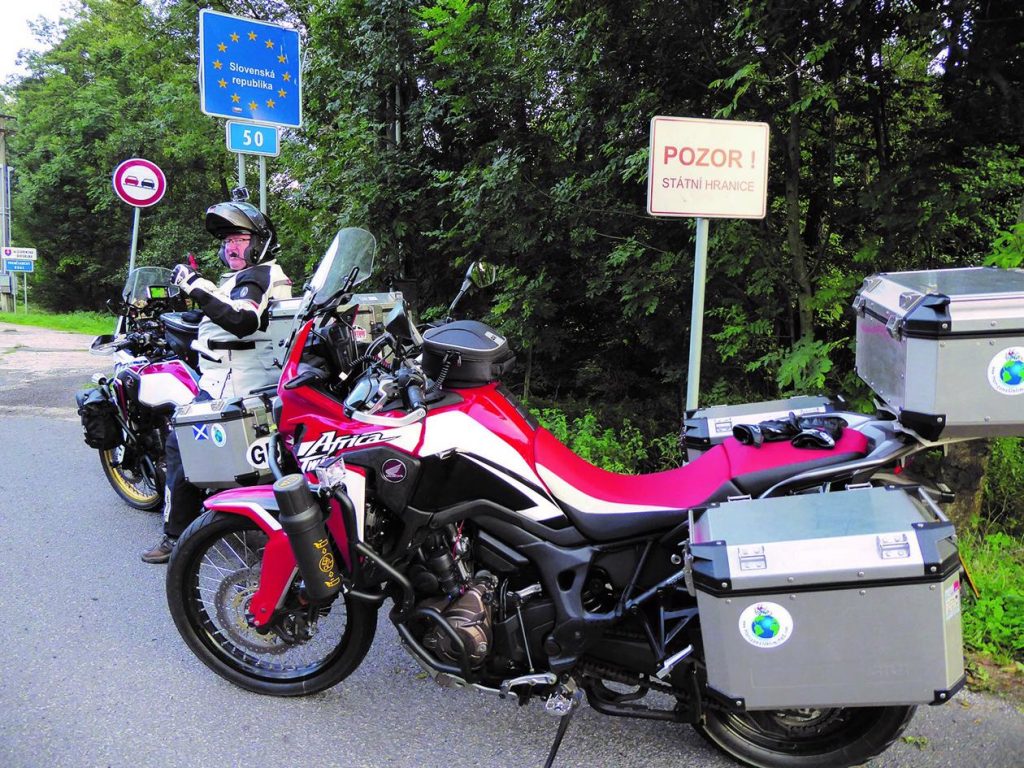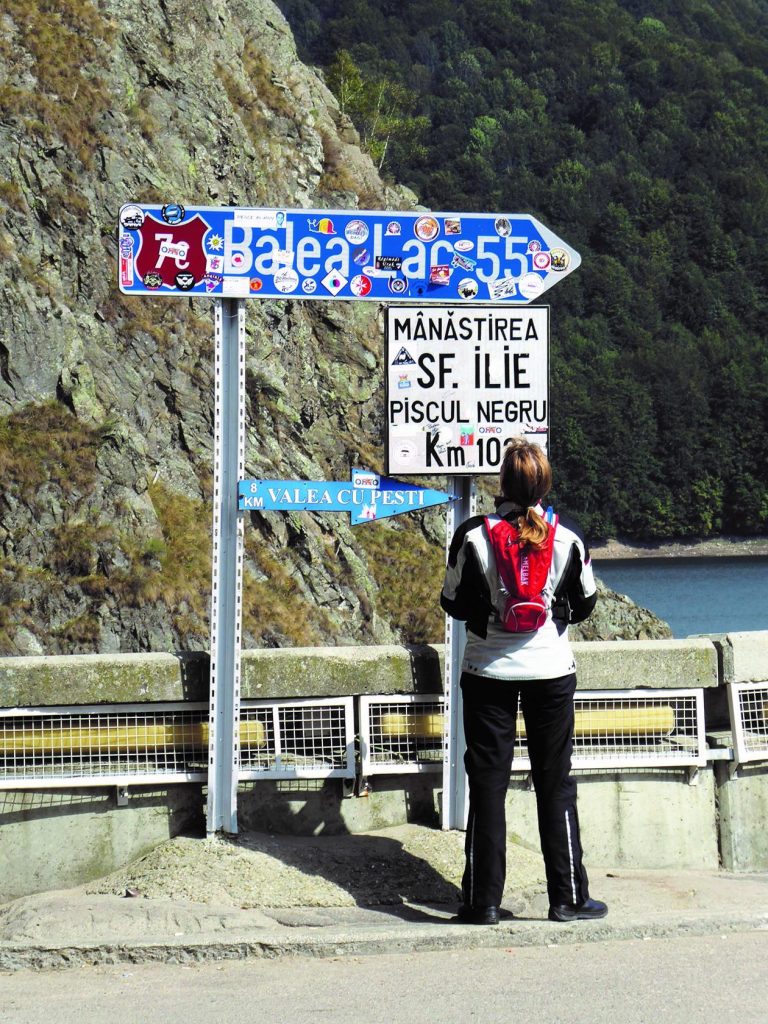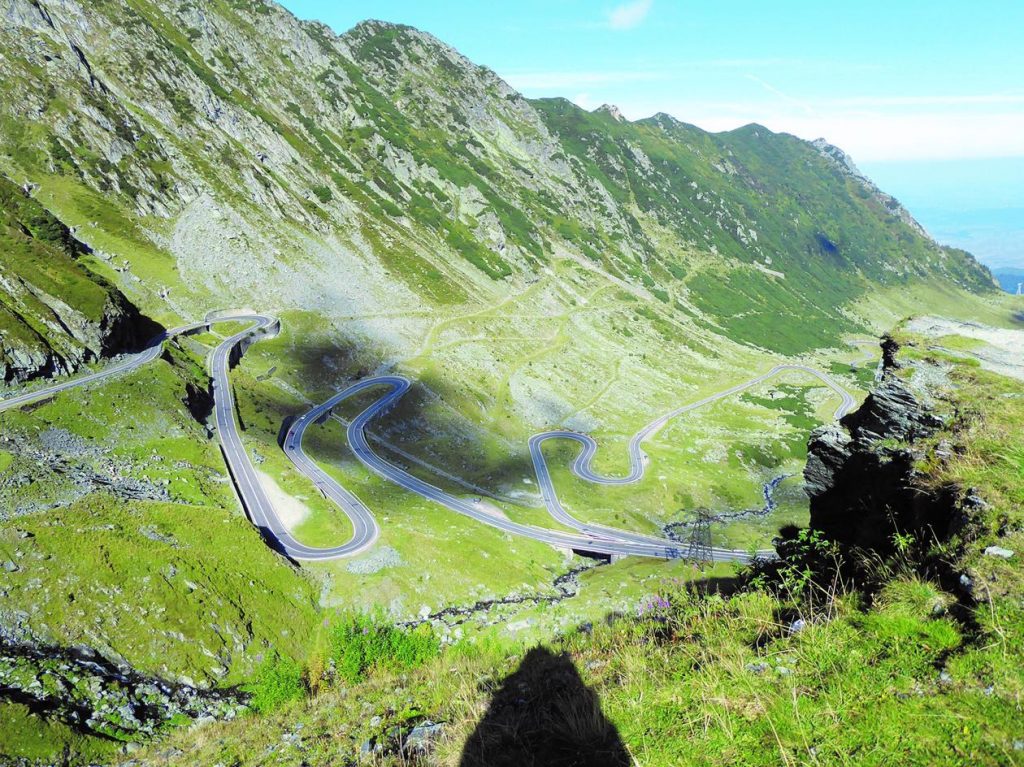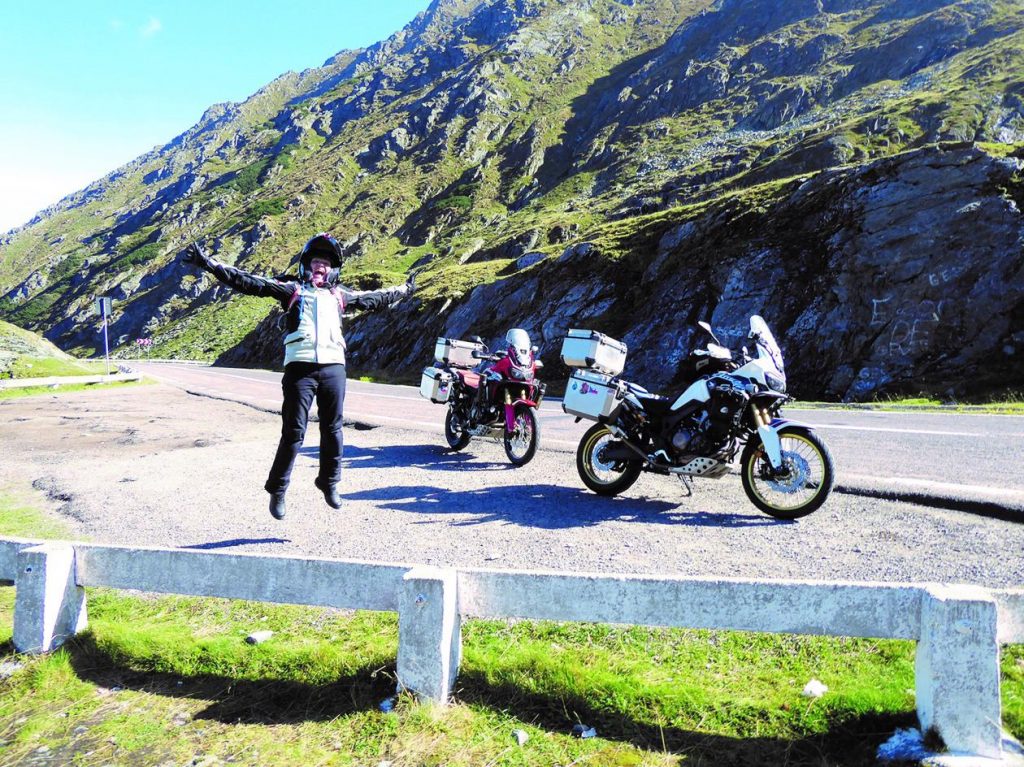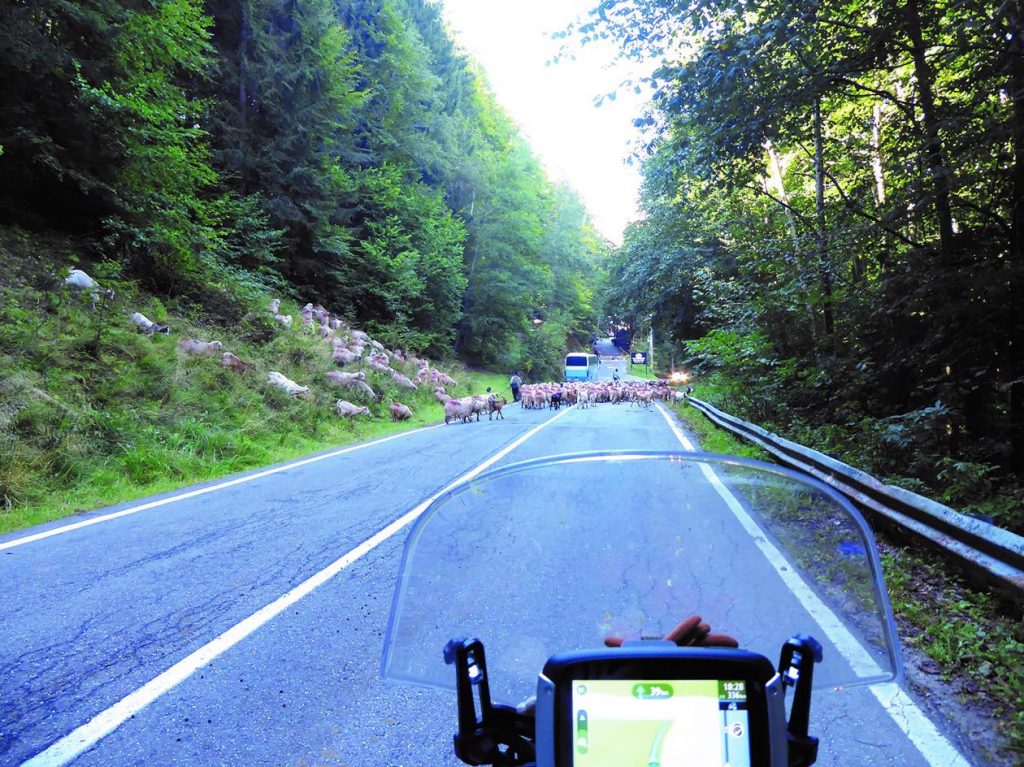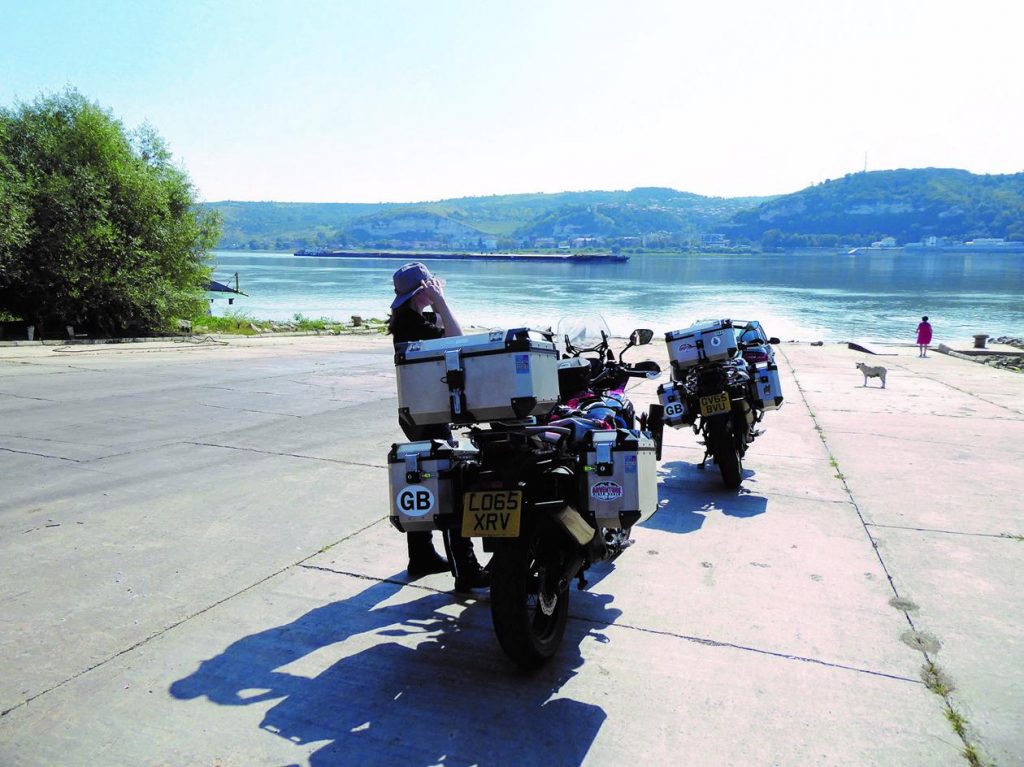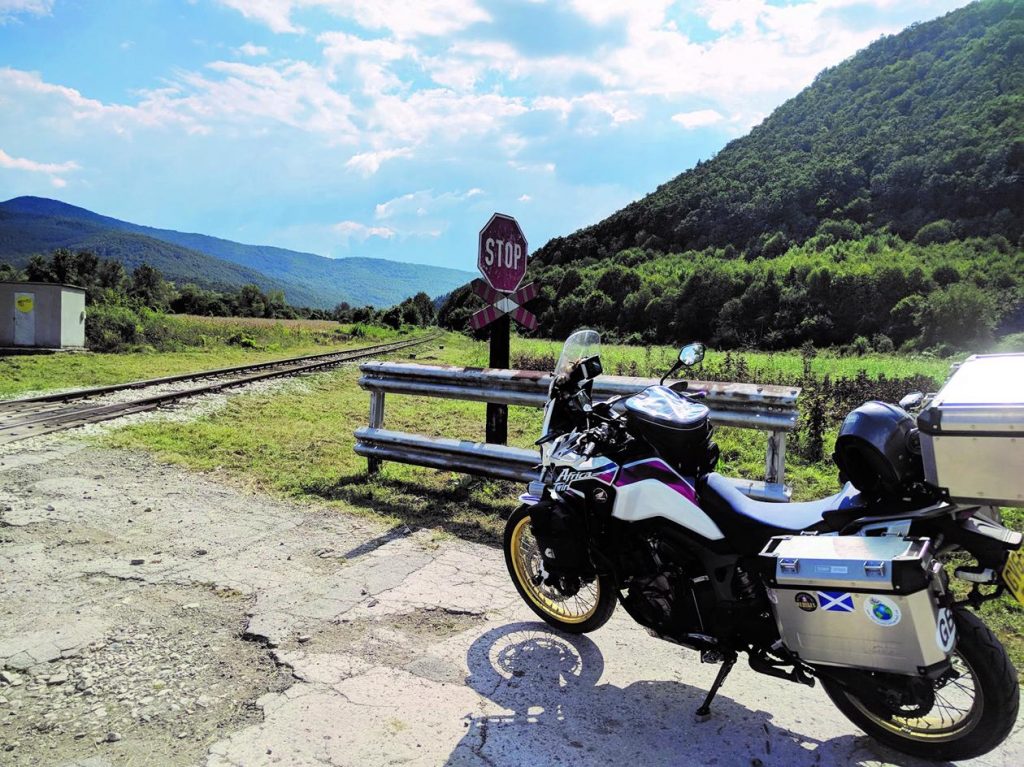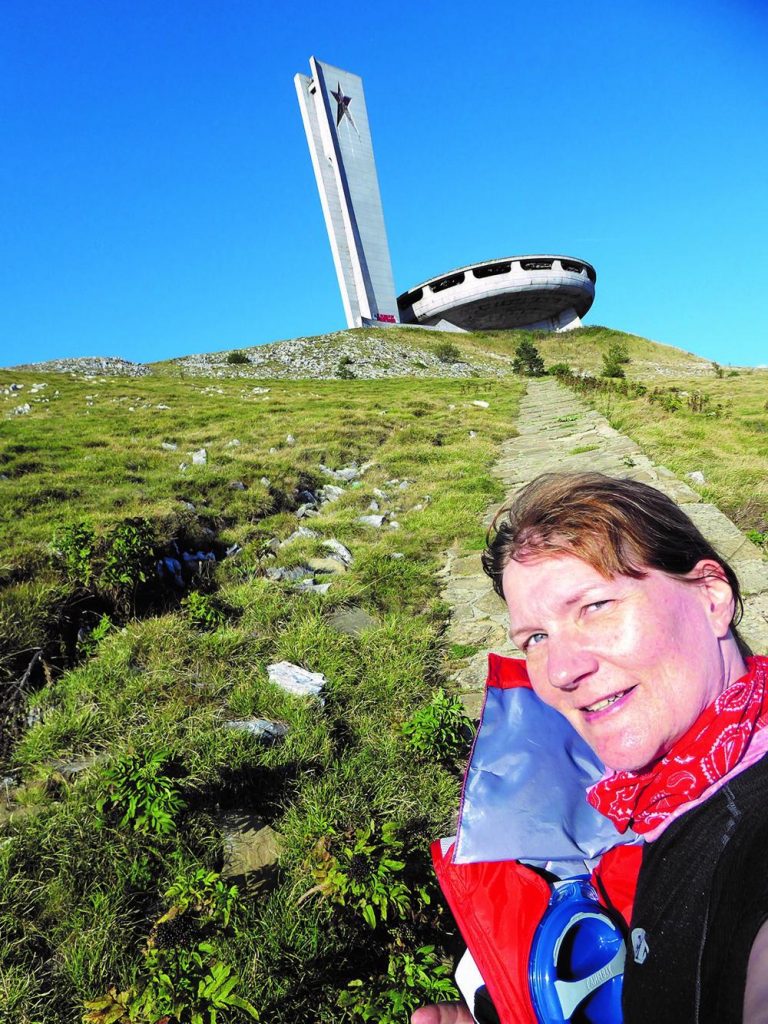Are you taking the piste?
The following morning it was cold but dry so after plenty of coffee and a filling breakfast we loaded up and headed back south to Agoudal where we turned off onto the R704. I’m not sure what the letters mean in front of the road names but in this case the R stood for ‘rough’. The 60km was an unmade road, only formed through usage by the locals over years.
We stopped to turn off rear ABS and traction control to low. On loose ground we needed the power delivery to stay on, especially riding up an incline, traction control cutting the power halfway up so you come to a complete stop and having to descend down backwards does not make for an enjoyable ride. Likewise, heading downhill, we didn’t want ABS kicking in when we really wanted the back wheel to lock and dig in to give some speed control.
Initially the track was soft soil which was largely dry, the rear wheel sliding around a bit on the damper sections. After a few miles we stopped to take it all in, we really were miles from anything here, just mountains and a track ahead of us which snaked and at times split before re-joining itself.
As we looked around a shepherd appeared as if from nowhere. Marije translated and we found out Amastan had hundreds of sheep in the surrounding area and due to the cold he was out checking on them.
As we rode further towards the mountains the track was largely gravel with larger rocks off to the sides. At one point the track split and I carried straight on before realising this way had larger rocks, the size of baby heads. Marc and Marije took the alternative which was much smoother but longer. I paused a moment and decided it would probably be harder to turn around than ride onwards. With a light touch on the bars, relaxed arms and fingers covering the controls the Africa Twin soaked it all up as long as I kept the momentum going, front wheel bouncing over the top rather than being deflected from side to side.
As we climbed higher the track become rougher and Marc sped ahead, his knobbly tyres biting into the rocks and loose sections. Our road tyres were performing remarkably well although this was in the dry, if it had been wet I think we would have struggled in places. Marc had stopped just as the valley down came into view and had put the kettle on, having his stove and brew kit in his top box. From this point we could look back at the path we’d ridden and Marc told us he could see us weaving as we hit the softer sections where he had powered through at speed, his DCT model handling all the gear changes to make sure the power delivery was smooth.
Looking down the valley ahead we could see the track was rough rock, covered in stones and gravel, with downhill straight sections and switchbacks with steep drops on one side. There wouldn’t be any look, lean and roll skills used today, sliding off could be a messy affair. After checking the ABS and traction control again, (which has the annoying feature of turning back on to max each time you switch the ignition off and on again), we headed down. The views down the valley were spectacular and the ride started to get more challenging, having to keep enough momentum going to ride out the bumps, controlling the speed with gentle inputs on the rear brake and letting the bike move around rather than forcing a line.
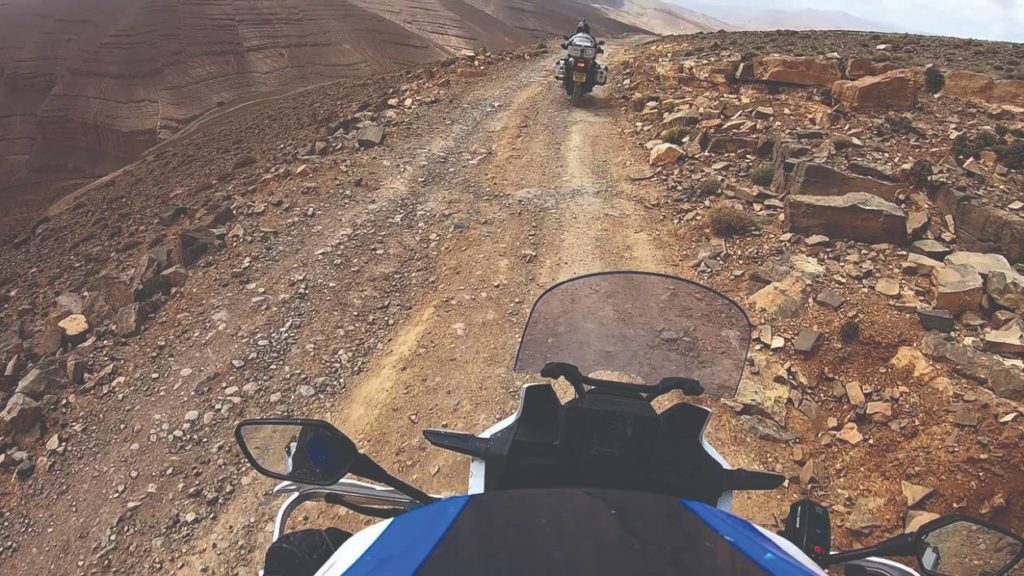
At this point I should say that Marije isn’t really that keen on off road riding but she had agreed to give it a go on the proviso that if she dropped the bike, I would be the one to pick it up. As I rode down one straight section I heard over the intercom “Oh, for goodness sake”. I stopped and looked in my mirror to see her bike on its side halfway around a switchback with Marije standing off to one side looking in my direction. I asked if she was ok, silence. Marije stood watching and waiting so I left my bike where it was and walked back up.
As we picked the bike up I asked what happened and she said it just went off balance when she’d hit a rock coming slowly around the bend. So rather than try and keep the heavy bike upright she’d let it go and stepped off, a good call, better than risking hurting herself. I started to explain that keeping some momentum going would help bounce over the rocks. I got the look. Time to shut up Damien.
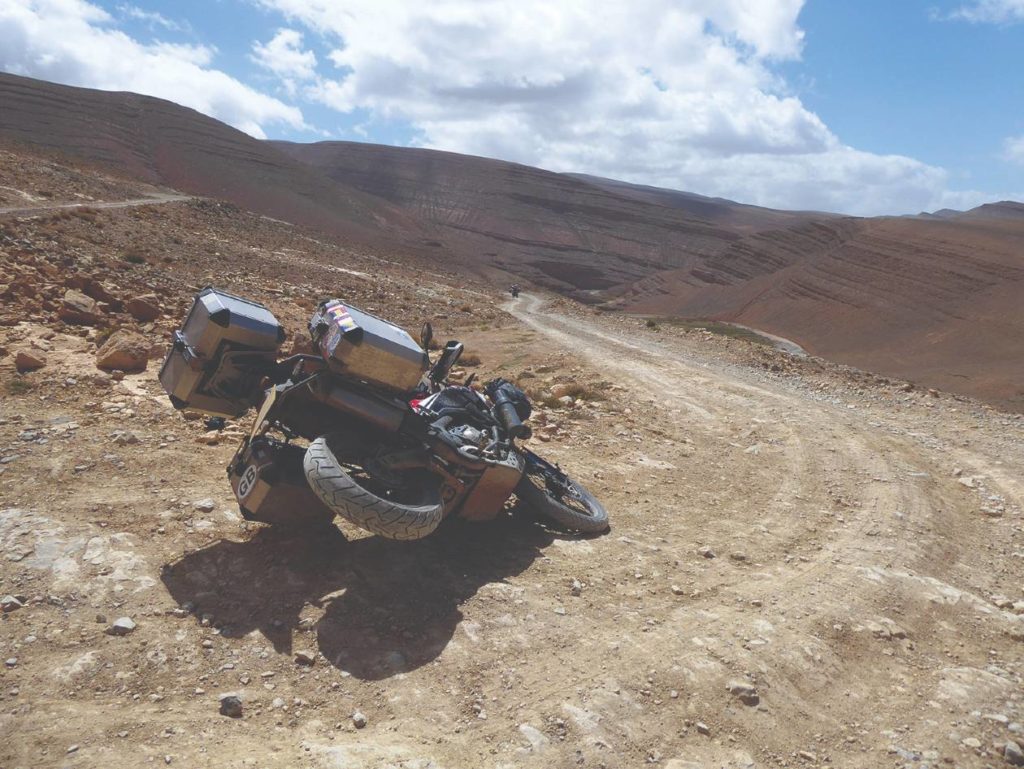
I was really impressed Marije was giving this a go even though it was well outside her comfort zone, especially after 50km of this terrain. I think if there had been a chance of getting a taxi at this point that bike may have been parked up for me to go back and collect!
Just as we re-joined tarmac road, Rob the fixer on his black Africa Twin passed us heading up towards the piste. We later found out when we met him on the return ferry that he’d got to the section Marije had taken a break on and decided it wasn’t wise to ride further on his own.
An hour later we got to the Dades gorge, a series of tight switchbacks and steep descent. We had a spirited ride down, then back up and down again. Who knew when we’d be back?
At this point we’d been riding every day for almost a week and the weather forecast for the following day showed thunderstorms and hail so we decided to take a day off in Ouarzazate, a town well known for film making. We checked in to a tourist hotel and explored the local markets and film museum, enjoyed a few cold beers and some Moroccan wine and sheltered from the storm.
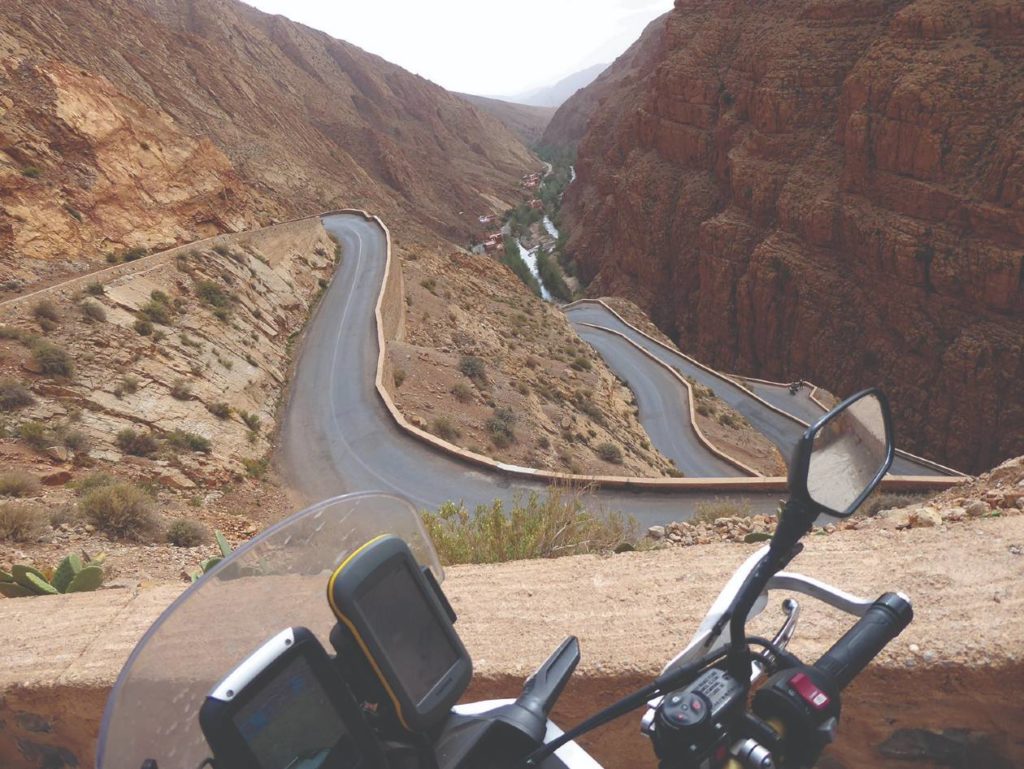
Marc and I played pool against the locals in the hotel bar on a pool table that looked like it had been surfaced in shag pile carpet, an interesting change! We had a hookah pipe brought to our table to share as this seemed to be the custom looking around. Although most Moroccans don’t drink and it’s a largely dry country, this seems to be by personal choice and there were several locals enjoying a beer in the bar. There was a small door that led to the street outside so they could enter without going through the hotel.
On the second night Marc and Marije synchronised watches as it had become a standing joke that we would be late for breakfast depending on which clock we looked at. We agreed to meet for breakfast at eight, pack up and head for Merzouga and the sand dunes of Erg Chebbi. This time Marc was late and after we’d eaten we packed up and waited for him in reception. Little did we know but back in the UK the clocks had gone forward, as had Marije’s clock, but this wasn’t observed in Morocco so we were an hour early. Marc relished the opportunity to enjoy breakfast and laugh at us all ready to go while he loaded up, it was usually the other way around!
Road to Merzouga
We left Ouarzazate and headed east on the N9, leaving dark storm clouds in our mirrors and the mountain adventures behind. The main roads here are good smooth tarmac and we could have ridden these almost all the way to Merzouga, but there are numerous small tracks off the road heading through open countryside. There are no barriers or fences to stop you picking a direction and heading straight off the main road to ride as you wish. We explored a few. The hardpacked sandy soil sections we did were easy to ride on but we had no idea where they went or if they remained like this all the way, they weren’t on any map or sat nav we had. It was also much slower than the main road so we eventually met up with the tarmac again and picked up the pace.
You may hear stories of zealous police doing speed checks and handing out big fines and we did encounter several police checkpoints, but only one was doing speed checks just after entering a town. At the rest of the checkpoints they pulled over vehicles seemingly at random, but they all waved us through apparently disinterested in foreigners.
Erg Chebbi
We had used booking.com to book a couple of days at the La Vallée des Dunes, a small auberge outside the main town with views of the dunes from the terrace. Erg Chebbi is roughly 28km long and 6km wide, a pre steppe to the Sahara, the sand rising up to 150m, it’s constantly changing dunes formed by the winds. On arrival we were greeted by the owner Mr Ali in both English and Dutch. Over the years he had picked up thirteen languages well enough for casual conversation – amazing! Once settled he directed us to a café bar where we could pick up some cold beers, our supply having been exhausted in Imilchil, while he prepared us dinner.
Riding the dunes
In the morning Ali offered to lead us to the dunes so we removed our panniers from the bikes in an attempt to make them as light as possible. As we followed him in his 4×4 towards the dunes we hit the soft sand and the bikes started to squirm around, having little to grip. As you ride, sand builds up in front of the front tyre until it’s high enough to deflect the wheel. It’s not a surface I’m adept at riding on. Marc struggled even with his knobblies and we decided to let some air out of the tyres at the base of the dunes to try and get more grip.
Having let the tyre pressures down I found it made little difference with my road tyres, riding on sand was just not going to work for me. Marc tried for a bit longer but even with his knobblies he gave up before even attempting a dune. The bikes were just too heavy, definitely not the right ones to try and learn dune riding on! But we’d given it a go and learned it really is a skill you have to work on.
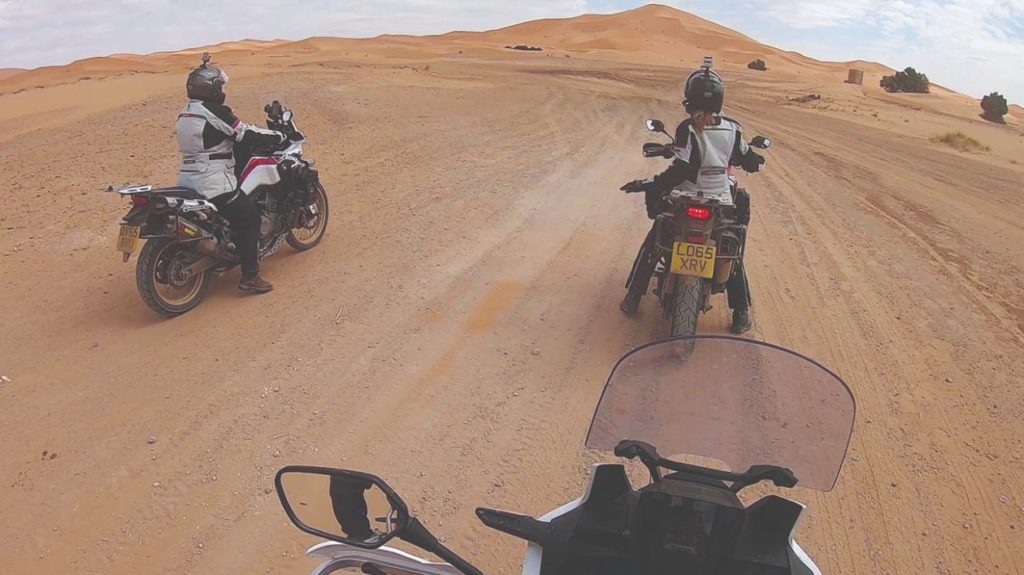
Marije wanted to walk up to the top of the dunes but with shifting sand under every footstep it would have been an arduous climb so we settled on booking some quad bikes Mr Ali had advertised at the auberge. After a few pictures we headed back, Marc and I continued to slide around while Marije seemed to take to it well, riding confidently across the sand with much more finesse than us.
An hour before sunset our quad bikes and guide arrived at the auberge. Our guide appeared to be about fourteen but he seemed to know his stuff as he briefed us on the controls and the importance of keeping in his tracks. We hit the dunes and realised these quads were ideal, they flew up with ease and we were all soon enjoying ourselves. At one point I cut across the edge of a dune, trying to keep up with our speedy guide but not following the tracks as instructed. I found myself leaning over as the quad fought to scramble up. I turned towards the bottom of the dune rather than risk rolling over and rode up the opposite side and back to re-join the others.
After half an hour we were high up overlooking a sea of sand and stopped to take in the views as the sun started to set. What a magical place to be! The low sun throwing the shapes of the dunes into relief and no signs of humanity in any direction.
As the group rode back through the dunes we came across tourists on camel trains and even a photoshoot with a woman in a meditation pose on top of a dune. It’s certainly popular here. Having parked up, our guide asked, “Did you enjoy? All good?”. Marc said, “It was a little slow.” “No really?” our guide replied looking surprised. “Like little old lady,” Marc responded. Everyone laughed and bill paid and guide tipped, his crew arrived and took the quads away. The forty euros it costs to hire one of these is without doubt worth it.
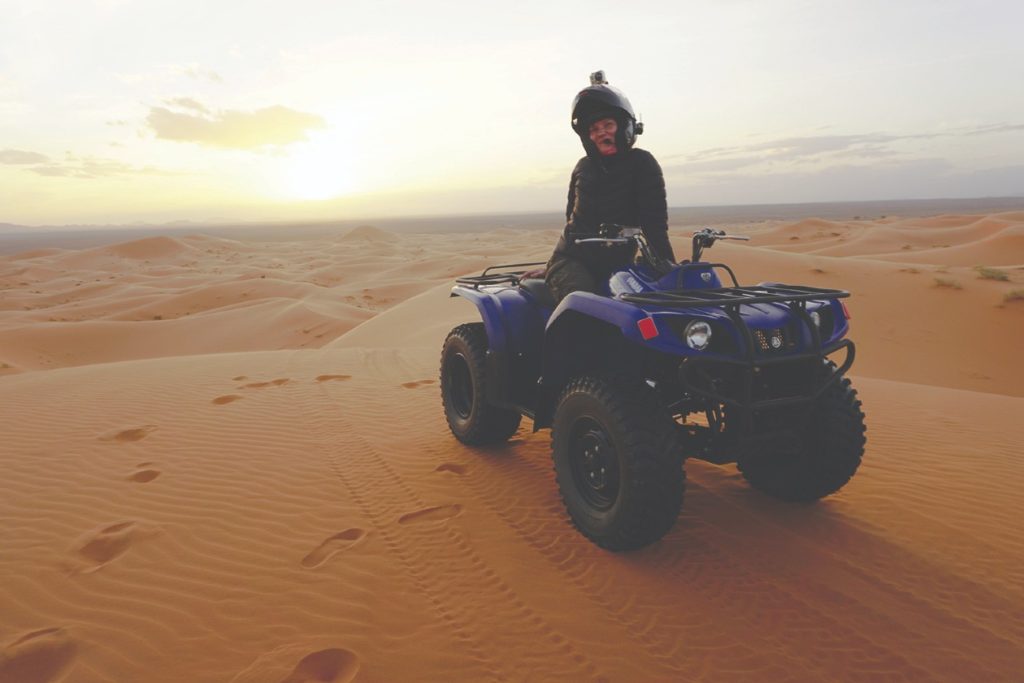
Puncture and the KTM shop
It was time to turn northwards having explored the areas we had set out to see and with two days before getting the ferry back to Spain. As we headed out from Merzouga, Marc rode up next to me and shouted “Puncture”, while pointing to the back of my bike. I pulled over to the side and looked at my rapidly deflating rear tyre. We’d planned for this as the Africa Twin runs tubed tyres and each of us carried some of a spares kit that worked for all the bikes. Included were two front and rear tubes, tyre irons and a compressor as well as the necessary tools. I had even practiced changing tubes in my garage at home.
Just as I was preparing to get tools out a young guy appeared and asked me if I wanted him to fix it. It seemed we had stopped outside a local bike mechanics shop, he had even painted KTM on the wall outside in orange paint! The owner was called Said and he ran the shop with his young son. They quickly had the back wheel off and replaced the tube with one of our spares and then patched and returned the old one, fantastic service and only £10. This was the only mechanical issue we had the whole trip.
The remainder of the ride north through Maroc was uneventful and we stayed a final night in the blue city of Chefchaouen, exploring its maze of backstreets and bazaars.
Spain
On arrival at the Tanger Med port we booked the next ferry and handed back our temporary import slips at customs. No x-ray for the bikes this time and the ferry was on time. We stopped in Madrid to have dinner with some friends of mine after a day of torrential rain and hail, neither of which worked for Marc’s well-worn knobbly tyres. We found out that northern Spain had been hit by the worst snowstorms in twenty years so needed to change our route on the final day to avoid the now closed high roads.
The twenty-four hour ferry crossing gave us another break and a chance to reflect on the trip as well as meet some of the bikers such as ‘Rob the fixer’ who we had met on the way down and exchange stories.
Looking back we wouldn’t have changed much. We had still packed too much, as on the Balkans trip. We should have camped in the open desert, given an ideal opportunity to ride away from the main roads in almost any direction and set up a camp.
Will we go back? Morocco is pretty much on our doorstep, has friendly people, amazing terrain and is culturally mixed, encompassing Berber, Arab, African, Mediterranean, and Jewish influences it feels vastly different to Europe. It would be great to experience it once more, perhaps on a longer trip once we’re able to travel again.
Marije may even agree to ride the R704 again, especially as I’ve heard it’s being paved over now.
Damien Murray
First published in Slipstream June 2021

